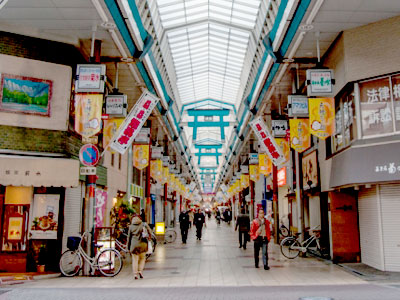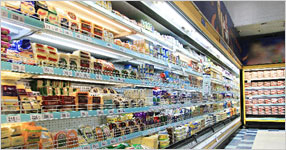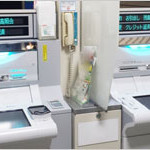Shopping for Necessities
Convenience stores, supermarkets, department stores, local shops—there are several different types of shops where you can buy your everyday goods in Japan. Here are a few tips about the products and services to expect from each.
Note: Japan is a cash-based society and you may not be able to use your credit cards at most places. It is a good idea to carry a certain amount of cash with you at all times just in case—don't worry, Japan has some of the lowest theft crime rates in the world, so you're in safe hands!
—Read the 'Money & Banking' page for more details.
Convenience stores

Convenience stores, abbreviated to "konbini" in Japanese, are an indispensable part of Japanese life and are used by locals, expats and tourists alike. The 'big 3' chains are 7-Eleven, Family Mart and Lawson, but there are numerous other regional ones as well. While America also has convenience stores and the UK has corner shops, they pale in comparison to the ridiculously accessible Japanese konbini. Open 24/7, 365 days a year, konbinis can practically be found around every other street corner in the larger cities. And if that's not nifty enough as it is, they also double as major landmarks to find your way around the city!
Let's take a look at the amazing things you can do at a Japanese konbini:
Everyday Essentials
The konbini's most basic function is to stock all the everyday essentials. Need to grab a hot lunch in a hurry? Pick up a konbini 'bento' lunch. Desperately need a litre of energy drink to keep you hydrated in Japan's hellish summer? Get a bottle or two at the konbini. Run out of toilet paper at 3am? No problem! Get down to the konbini and stock up. This is just a few of the items konbini keep in stock:
Food products: snacks, drinks, lunch items (bento), hot food, frozen food, ice cream, fresh fruit & veg (sometimes, and limited range);
Toiletries: toilet paper, tooth paste, soap, deodorant, hygiene products (male and female), makeup, shampoo, towels; and
Other: stationary, batteries, tights, shirts, umbrellas & rain gear.
The only downside for shopping for essentials at a konbini is that it is slightly more expensive than shopping at a supermarket or local store.
ATMs
Almost all konbinis have an ATM where you can withdraw and deposit money with a Japanese bank card. You can also make withdrawals using an international card if you use a 7-Eleven ATM, where the machine will also have an English display option. Konbini ATMs are tall free-standing units that can usually be found in a corner of the shop.
Pay Bills
If you are an expat living in Japan, you can stroll down to your local konbini and pay all of your bills over the counter, including utilities (gas, water, electric), phone and even your tax bills. Just hand them to the store attendant at the counter, press OK on the confirmation screen when prompted, then hand over your cash. The attendant will hand you your receipts, then you're all done!
Printing Facilities
Near the ATM you'll usually find a photocopier. Services will vary by which konbini you are at, but you can print, scan, copy or fax documents (in PDF, not Word) and photos for a few yen per page. These machines are compatible with a range of data devices, including USBs and SD cards. If you don't know how to work the machine just ask a member of staff to help you.
Postal Services
While konbinis don't offer the most comprehensive range of postal services, you are able to buy stamps for your letters, as well as drop off or pick up deliveries, known as 'takkyubin' (participating stores only).
Ticket Machines
Near the ATM and photocopier you may also find a smaller free-standing machine. This is a ticket machine and you can use it to buy or reserve tickets for flights, concerts, sports, and so on. Of course, you could buy the tickets online instead, but you can only do this if you have a Japanese credit card as many Japanese websites unfortunately do not accept foreign credit cards.
This is where these konbini ticket machines come in handy, because they allow you to pay in cash. You can search on the machine itself for tickets, but it may be easier to reserve them online first and select "konbini" as the payment option. The ticket company will send you a reservation code (and possibly a link to the payment instructions), which you use to plug into the machine, confirm the amount to be paid, and pick up the receipt the machine gives you. You take this receipt to the konbini counter within half an hour and pay for it there with cash.
It is worth noting that these machines are in Japanese only, but if you have managed to get an online reservation number sent to you by email, you can just show this to the store clerk so they can do it for you.
Toilets
Most konbinis will have a public toilet that is free for anyone to walk in and use. Usually they only have one rather than being separated by gender.
Supermarkets & Department Stores
Supermarkets
Japanese supermarkets are more similar to the Western grocery store in that they exclusively stock food and perishable items; however some may also have a home-ware department attached or nearby where you can buy kitchen-ware and utensils, bathroom necessities, and so on.
Even though Japanese supermarkets offer a wide range of products, it can be difficult to get hold of certain Western ingredients if it is not commonly used in Japanese cuisine. If you can't find something that you are looking for, you will have to see if you can get hold of it at an import store. Instead, you will find many unfamiliar products in a Japanese supermarket which you will have no clue what they are or what to do with them. Before heading out for your first expeditions, it may be best to make a shopping list and look up the Japanese terms for the items, including the Kanji (Chinese characters) for them. If you struggle to find them yourself, you could always show this to a member of staff who can guide you in the right direction.
In Japan, you pack your shopping bags yourself on the packing table after going through the checkout. Do not do it at the checkout itself. Some supermarkets may have 9-5 opening hours, but most tend to close around 8 or 9pm, with some even as late as 11pm.
Department Stores
Much like department stores in the West, Japanese department stores can vary greatly in size, but those in the bigger cities are often massive complexes that extend over numerous floors and across several buildings. Other than having a supermarket on one of the lower floors, you may also find any combination of clothes stores, restaurants, a cinema, a games arcade, a workshop classroom (for cooking etc.) or possibly a sky garden.
Department stores are great places for clothes shopping, but like in many other countries are the most expensive places to shop, so may be best left as a treat!
Grocery & Local Shops

Alongside the konbinis, supermarkets and department stores, you can also get your daily necessities in the independently-run stores dotted along the streets. Japan has a great fondness for keeping shops for different products separate, be it small grocery stores, bakeries, drug stores, and so on. You also tend to find these shops clustered together on the same shopping street, which is called a "shoutengai". Each shop tends to stock a wider range of products than their supermarket or department store counterparts as they are specialised, but it varies depending on the size of the store. They tend to close the earliest out of all the different store options.
Online Shopping
If your foreign credit card isn't accepted by certain websites, there are other payment options available which you can select on the website's payment screen. Each website will have preferred payment methods and you can choose out of them which one is best for you:
Japanese Credit Card
This is the simplest payment method but it can be hard to get a hold of one, as you would typically need to have a permanent resident status or Japanese spouse.
Pre-Paid Store Card
You can purchase these cards at convenience stores for various top-up amounts. You can get some which are specific to a certain store (e.g. Amazon.co.jp, iTunes) and some which are general. However, note that not all stores will accept the general-use ones.
Bank Transfer
Some websites may allow you to pay via bank transfer. However, you would have to do this in person within ATM hours at the bank or post office and would incur transaction fees. See the 'ATMs' section for more details on making electronic bank transfers.
Convenience Store Ticket Machine
Websites will often have the option to pay at a konbini portal/machine. See the 'Ticket Machines' section for more details.
COD (Cash on Delivery)
If all else fails, COD is a very common payment option in Japan. Just select this option on the website's payment screen and wait until your item is delivered. When it comes all you have to do is pay the delivery man with the exact change.
Our tips:
However, we do not take responsibility should there be any inaccuracies or incorrect information shown.
Please use your own judgement about what you read here – From the organisers of japanbizguide.com





